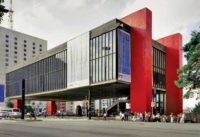A Rammed-Earth Wall for the Ages at Nk'Mip Desert Cultural Centre
Osoyoos, British Columbia

In Canada, A Rammed-Earth Wall for the Ages
The center, the hub of a 1,600-acre nature preserve about 250 miles straight east of Vancouver, was designed to call attention to a landscape increasingly endangered by sprawl.
Photo © Nic Lehoux

In Canada, A Rammed-Earth Wall for the Ages
It opened in June 2006, and it cost nearly $3.5 million.
Photo © Nic Lehoux

In Canada, A Rammed-Earth Wall for the Ages
Formwork for rammed-earth construction is similar to that of concrete, although construction is more time consuming.
Photo courtesy Brady Dunlop/HBBH

In Canada, A Rammed-Earth Wall for the Ages
The contractors say rammed-earth walls such as this one will withstand a 3,500-psi water stream.
Photo courtesy Brady Dunlop/HBBH

In Canada, A Rammed-Earth Wall for the Ages
The contractors say rammed-earth walls such as this one will withstand a 3,500-psi water stream.
Photo courtesy Brady Dunlop/HBBH

In Canada, A Rammed-Earth Wall for the Ages
A rendering illustrates the scope of the project.






Bruce Haden, a principal at HBBH, says he tried to resist the traditional choice of ersatz regional architecture, like that found in Santa Fe’s fake adobe buildings. “We wanted a building that was simultaneously modern and spoke to the landscape and the contemporary traditions of the Osoyoos Indian Band,” he says. Although the 12,000-square-foot center—used as an exhibition and meeting space by the Osoyoos—disappears behind the earthen wall and under a vegetated roof, these two highly visible sustainable design elements support a comprehensive energy-efficient project that also relies on radiant heating and cooling.
The west-facing, 24-inch-wide rammed-earth wall, bolstered with an internal layer of Styrofoam insulation, performed well enough to resist summertime temperatures that can reach 100 degrees F. The wall consists of local dirt, with organic matter filtered out, combined in a mix of 10 percent concrete and color additives (to get that clean, layered look). Contractors from British Columbia’s Terra Firma Rammed Earth Builders laid down each strip and then mechanically tamped it down to 50 percent of its original height. Haden says it was more labor intensive and expensive than concrete, but his hope is to encourage more rammed-earth architecture in the region by training locals in the construction methods. “If this could become a more generic material, it could foster a modern and regional aesthetic,” Haden says.



